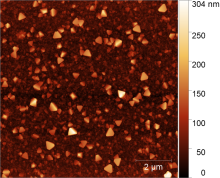Metal Organic Frameworks - a class of crystalline, porous coordination polymers
One of the main areas of research at the Institute of Physical Chemistry is in the field of metal-organic frameworks (MOFs for short). The representatives of this class of materials are characterised by a bimodular structure of inorganic nodes, so-called secondary building units (SBUs for short), and organic linker units coupled with the properties of permanent porosity and high long-range order. This makes it possible to imagine various possible applications in the fields of catalysis, gas storage, sensor technology and material separation.
Electrical conductivity of MOFs
A special method is the combination of conductivity measurements with the AFM and the possibility of heating the sample. This makes it possible to record temperature-dependent current-voltage curves. These can be used to draw conclusions about the occurring conductivity mechanism and to calculate the activation energy of the charge transport. Coordination polymers, such as Rh2(acam)4(pyz)]n (see below), can be assigned semiconducting properties, for example, as the measured current rises sharply with increasing temperature.

Thermal decomposition of MOFs
The aim of our research continues to be the production of catalytically active materials through the thermal decomposition of MOFs. The decomposition in O2-containing atmosphere (calcination), inert atmosphere (pyrolysis) or H2-containing atmosphere (reduction) is analysed using TG-DSC and AFM. The metal-containing nanoparticles generated in this way and the decomposition products obtained are then characterised using various methods such as SEM, AFM, XRD, FTIR and MS. Various test rigs are available at our institute for the subsequent investigations into the suitability of these particles as calatysers; further information can be found here.
Calcination of HKUST-1 on SiO2 surfaces
Thermal decomposition of MIL-88A
Further research activities
The physicochemical investigation of known synthesis strategies and novel approaches, such as room temperature synthesis using the controlled SBU approach for both known and new metal organic frameworks, is another aspect of our research activities. Among other things, the mechanism and synthesis conditions are investigated with regard to the requirements for crystallite size, purity and specific surface area. The MOF systems investigated include MOF-5, HKUST-1 and MIL-88A.
In addition to research activities in the field of catalysis and conductive MOFs, one focus is on the separation of substances via the gas phase using various representatives of porous coordination polymers as stationary phases in chromatographic columns. This work is being carried out as part of the priority programme 1362 of the German Research Foundation DFG in the sub-project "Liquid phase epitaxy (LPE) of functionalized SURMOFs for application in Gas Chromatography". The aim of this work is the deposition of various MOFs in thin quartz glass capillaries (length: 10-30 m, inner diameter: 0.53-0.25 mm) for use in gas chromatography. The subsequent separation performance has so far been demonstrated in the separation of various mixtures of substances, such as branched and unbranched alkanes, BTEX aromatics, Lewis-based compounds and chiral analytes.
The specific adsorption behaviour of different compounds is investigated at the institute using various methods, such as infrared spectroscopy and inverse gas chromatography. With the latter method, for example, kinetic (diffusion and mass transfer coefficients) and thermodynamic constants (adsorption enthalpies, adsorption entropies) can be determined, which provide deep insights into the adsorption process.
Selected publications:
on the electrical conductivity of coordination polymers and MOFs
- D. Steinbach, S. Gersdorf, J. Heitmann, F. Mertens, "Charge Transport of Coordination Polymers Containing Rhodium Paddle-Wheel Units", accepted to Journal of Physical Chemistry dx.doi.org/10.1021/acs.jpcc.2c04632
for synthesis:
- S. Hausdorf, F. Baitalow, J. Seidel, F. Mertens, "Gaseous Species as Reaction Tracers in the Solvothermal Synthesis of the Zinc Oxide Terephthalate MOF-5", J. Phys. Chem. A 2007, 111(20), 4259-4266, dx.doi.org/10.1021/jp0708291
- S. Hausdorf, F. Baitalow, T. Böhle, D. Rafaja, F. Mertens, "Main Group and Transition Element IRMOF Homologues", J. Am. Chem. Soc. 2010, 132, 10978-10981, dx.doi.org/10.1021/ja1028777
for the deposition of MOFs on surfaces:
- A. S. Münch, M. S. Lohse, S. Hausdorf, G. Schreiber, D. Zacher, R. A. Fischer, F. Mertens, "Room Temperature Preparation Method for Thin MOF-5 Films on Metal and Fused Silica Surfaces Using the Controlled SBU Approach", Microporous and Mesoporous Materials 2012, 159, 132-138, dx.doi.org/10.1016/j.micromeso.2012.04.023
on gas chromatography with MOFs:
- A. S. Münch, F. Mertens, "HKUST-1 as an open metal site gas chromatographic stationary phase - capillary preparation, separation of small hydrocarbons and electron donating compounds, determination of thermodynamic data", J. Mater. Chem. 2012, 22, 10228-10234, dx.doi.org/ 10.1039/C2JM15596F
- A. S. Münch, J. Seidel, A. Obst, E. Weber, F. Mertens, "High Separation Performance of Chromatographic Capillaries Coated with MOF-5 by the Controlled SBU Approach", Chem. Eur. J. 2011, 17(39), 10958-10964, dx.doi.org/10.1002/chem.201100642
Contact person
- Prof. Dr Florian Mertens (e-mail: Florian [dot] Mertens [at] chemie [dot] tu-freiberg [dot] de (Florian[dot]Mertens[at]chemie[dot]tu-freiberg[dot]de))
- Dr Erik Schumann (e-mail: Erik [dot] Schumann [at] chemie [dot] tu-freiberg [dot] de (Erik[dot]Schumann[at]chemie[dot]tu-freiberg[dot]de))
- Bernhard Berger (e-mail: bernhard-claus [dot] berger [at] student [dot] tu-freiberg [dot] de (Bernhard-Claus[dot]Berger[at]student[dot]tu-freiberg[dot]de))
